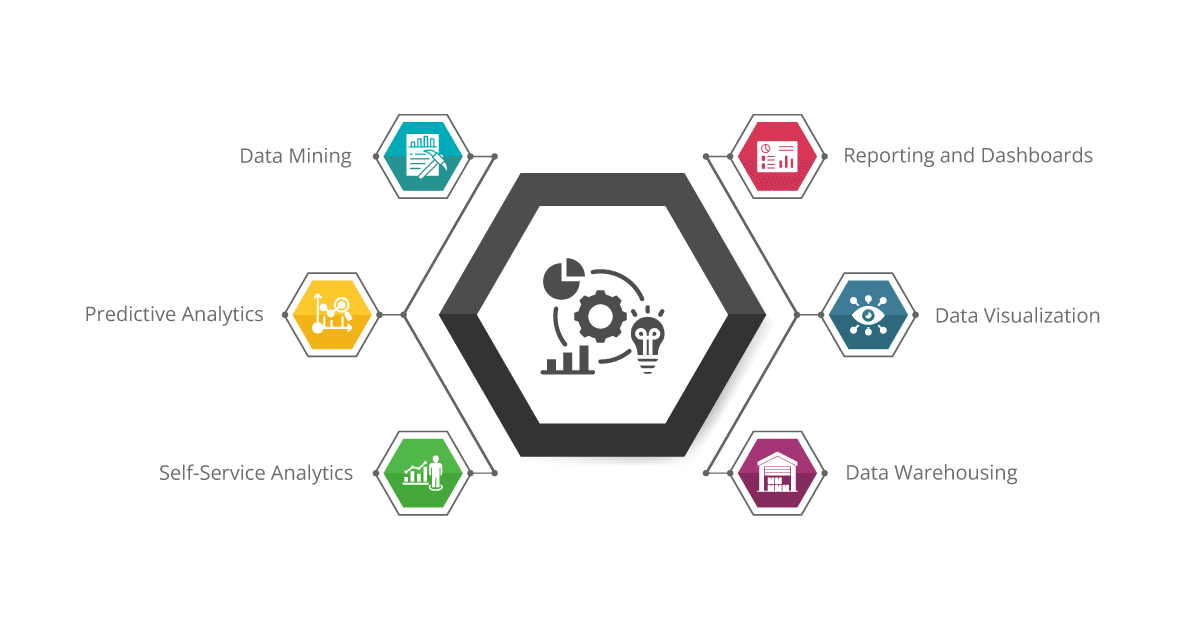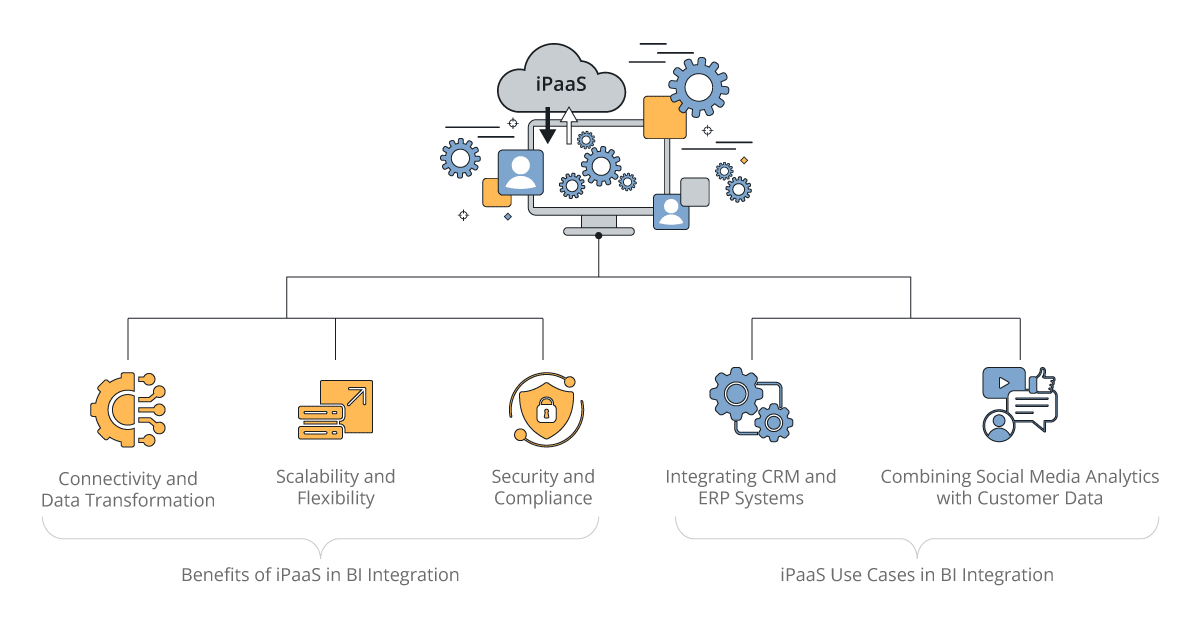A data-driven business landscape demands organizations to constantly stay competitive by leveraging their data effectively. Business Intelligence (BI) tools have emerged as powerful solutions that enable companies to transform raw data into actionable insights. By integrating various BI tools, businesses can unlock the true potential of their data, drive informed decision-making, and achieve improved operational efficiency. This article explores the benefits of integrating BI tools, providing examples and use cases to highlight their value. Additionally, we will delve into the role of iPaaS (Integration Platform as a Service) in facilitating seamless connectivity between disparate BI tools.
Aonflow iPaaS – Free for First 3 Months!
Build and run up to 1,500 transactions monthly with no cost. No payment info needed!
Understanding Business Intelligence Tools
Business Intelligence tools encompass a range of technologies and methodologies that help organizations collect, analyze, and present data to support decision-making processes. These tools provide insights into various aspects of business operations, including sales, marketing, supply chain management, and finance. Let’s explore some common types of BI tools:
A. Reporting and Dashboards
Reporting tools enable organizations to generate standardized reports based on pre-defined parameters. Dashboards, on the other hand, offer visual representations of data, allowing users to monitor key performance indicators (KPIs) and track progress in real-time.
B. Data Visualization
Data visualization tools help users interpret complex datasets through interactive and visually appealing charts, graphs, and maps. These tools enable users to spot trends, identify outliers, and gain a deeper understanding of their data.
C. Data Warehousing
Data warehousing tools store and organize large volumes of structured and unstructured data from disparate sources. By centralizing data, organizations can perform comprehensive analysis and generate insights from a single, unified source.
D. Self-Service Analytics
Self-service analytics tools empower non-technical users to explore and analyze data without relying on IT support. These user-friendly interfaces enable individuals to create their reports, visualizations, and ad-hoc analyses.
E. Predictive Analytics
Predictive analytics tools leverage historical data and statistical algorithms to forecast future trends and outcomes. These tools enable organizations to make data-driven predictions and optimize their decision-making processes.
F. Data Mining
Data mining tools use advanced algorithms to discover patterns, correlations, and relationships within large datasets. By uncovering hidden insights, organizations can identify opportunities, detect anomalies, and gain a competitive advantage.
The Power of Integration
Integrating multiple BI tools can significantly enhance an organization’s data analytics capabilities. Let’s explore the key benefits of integrating BI tools:
A. Enhanced Data Accessibility
Integrating BI tools enables seamless connectivity to multiple data sources, such as databases, spreadsheets, and cloud applications. This connectivity eliminates data silos, allowing organizations to access and analyze data from various systems in a unified manner. Furthermore, integration facilitates real-time data updates, ensuring that insights are based on the most current and accurate information.
For example, imagine a retail company that integrates its sales data from the point-of-sale system with its customer data from the CRM system. This integration would provide a comprehensive view of customer purchasing behavior, allowing the organization to identify trends and tailor marketing campaigns accordingly.
B. Holistic Data Analysis
By integrating BI tools, organizations can gain cross-tool insights, enabling them to analyze data from different perspectives. For instance, combining data from sales, marketing, and customer support can provide a comprehensive understanding of the customer journey, from initial contact to post-purchase engagement. This holistic view enables businesses to identify areas for improvement and optimize their strategies.
Moreover, integrated BI tools allow for consolidated reporting and visualization. Instead of relying on separate reports and dashboards, organizations can create comprehensive executive dashboards that present a holistic overview of key metrics and KPIs. This streamlined approach enhances decision-making by providing a clear and concise picture of business performance.
C. Improved Data Quality and Consistency
Integration plays a crucial role in eliminating data silos, ensuring data governance, and promoting data standardization. When data is scattered across various systems, inconsistencies, and discrepancies are likely to arise. Integrating BI tools allows for data validation, cleansing, and standardization, leading to improved data quality and consistency.
For example, integrating a data warehousing tool with a data governance tool enables organizations to establish rules and standards for data collection, storage, and usage. This ensures that data is accurate, up-to-date, and compliant with regulatory requirements.
Aonflow is the leading integration platform.
You can kick-start by integrating your first-ever workflow in just a matter of minutes.
Use Cases and Examples
Integrating BI tools can yield powerful insights and drive actionable outcomes across various business functions. Let’s explore some use cases and examples:
A. Sales and Marketing
Customer Segmentation and Targeting: By integrating CRM data with demographic and transactional data, organizations can identify customer segments based on buying patterns, preferences, and behavior. This integration enables personalized marketing campaigns and tailored product recommendations.
Campaign Performance Analysis: Integrating marketing automation tools with BI tools allows organizations to track and analyze the effectiveness of marketing campaigns in real time. By monitoring metrics such as click-through rates, conversion rates, and customer engagement, businesses can optimize their marketing strategies and allocate resources more effectively.
B. Supply Chain Management
Inventory Optimization: Integration between BI tools and inventory management systems enables organizations to analyze historical sales data, demand forecasts, and supplier performance. This integration provides insights into inventory levels, lead times, and reorder points, allowing businesses to optimize their inventory management and reduce carrying costs.
Supplier Performance Monitoring: By integrating supplier data with BI tools, organizations can evaluate supplier performance based on factors such as on-time delivery, quality metrics, and pricing. This integration enables proactive supplier management, identifying potential bottlenecks and fostering stronger supplier relationships.
C. Financial Analysis
Budgeting and Forecasting: Integrating financial planning and budgeting tools with BI tools enables organizations to generate accurate forecasts based on historical financial data and market trends. This integration streamlines the budgeting process, facilitates scenario analysis, and enhances financial decision-making.
Fraud Detection: By integrating transactional data with predictive analytics tools, organizations can detect patterns and anomalies that may indicate fraudulent activity. This integration enables real-time monitoring and alerts, minimizing financial losses and preserving organizational integrity.
Human Resources Analytics: Integrating HR systems with BI tools enables organizations to analyze employee data comprehensively. By combining data from performance management systems, training records, and employee satisfaction surveys, HR professionals can gain valuable insights. For example, they can identify top-performing employees, evaluate the effectiveness of training programs, and measure employee satisfaction levels. These insights can inform decisions related to talent management, succession planning, and employee engagement initiatives, leading to a more productive and motivated workforce.
Customer Experience Management:
Integrating customer feedback data from various sources, such as surveys, social media, and customer support systems, with BI tools provides a holistic view of the customer journey. Organizations can analyze sentiment analysis, customer satisfaction scores, and feedback trends to identify pain points and areas for improvement. For instance, by analyzing customer feedback, a telecommunications company might discover that a specific feature of their mobile app is causing frustration among users. This insight can prompt the company to make improvements, leading to enhanced customer satisfaction and loyalty.
E-commerce Analytics:
Integrating e-commerce platforms with BI tools allows organizations to analyze sales data, customer behavior, and website traffic. This integration enables businesses to identify trends, optimize pricing strategies, and enhance the customer journey. For example, an online retailer can analyze sales data to identify popular products, optimize inventory levels, and plan marketing campaigns accordingly. By understanding customer behavior, such as browsing patterns and purchase history, organizations can personalize the shopping experience and increase conversion rates.
Operational Efficiency Analysis:
Integrating operational data from manufacturing systems, supply chain management tools, and IoT devices with BI tools provides organizations with real-time visibility into their operations. By analyzing this data, businesses can identify inefficiencies, optimize processes, and reduce costs. For instance, a manufacturing company might integrate data from their production lines to monitor equipment performance, detect bottlenecks, and identify areas for improvement. This integration enables proactive maintenance, minimizes downtime, and enhances overall operational efficiency.
Risk Management:
Integrating risk data from various sources, such as compliance systems, internal audits, and external market data, with BI tools, allows organizations to assess and mitigate risks effectively. By analyzing risk indicators and historical data, businesses can identify potential risks and make data-driven decisions to minimize their impact. For example, a financial institution can integrate data from fraud detection systems, transaction monitoring tools, and market data to identify patterns and anomalies that may indicate fraudulent activity. This integration enhances risk management practices and helps protect the organization’s assets and reputation.
Healthcare Analytics:
Integrating electronic health records (EHR) and patient data with BI tools enables healthcare providers to gain insights into patient outcomes, treatment effectiveness, and resource utilization. By analyzing this data, healthcare organizations can identify trends, improve care delivery, and enhance operational efficiency. For instance, by integrating EHR data with clinical outcomes and treatment protocols, hospitals can analyze patient data to identify best practices, reduce readmission rates, and improve patient outcomes.
Social Media Analytics:
Integrating social media platforms with BI tools allows organizations to analyze social media data comprehensively. By tracking brand mentions, customer sentiment, and engagement metrics, businesses can gain insights into brand perception, monitor social media campaigns, and identify emerging trends or issues. For example, a consumer goods company can integrate social media data with sales data to analyze the impact of social media campaigns on sales performance. This integration helps organizations make data-driven decisions to optimize their social media strategies and enhance brand reputation.
Supply Chain Analytics:
Integrating data from suppliers, logistics systems, and inventory management tools with BI tools enables organizations to optimize their supply chain operations. By analyzing this data, businesses can identify inefficiencies, manage inventory levels, and improve overall supply chain performance. For instance, a retail company can integrate supplier data, transportation data, and sales data to optimize inventory levels, reduce stockouts, and minimize transportation costs. This integration facilitates data-driven decision-making, streamlines the supply chain, and enhances customer satisfaction.
Financial Fraud Detection:
Integrating financial transaction data from multiple systems, such as payment processors, banking systems, and internal accounting tools, with BI tools allows organizations to detect and prevent financial fraud. By analyzing patterns, anomalies, and historical data, businesses can identify suspicious activities and take proactive measures to prevent fraud. For example, a financial institution can integrate transactional data with predictive analytics tools to detect anomalies that may indicate fraudulent transactions. This integration helps organizations minimize financial losses, protect customer data, and maintain trust in their financial systems.
Project Management Analytics:
Integrating project management tools with BI tools enables organizations to monitor project progress, resource allocation, and budget performance. By analyzing this data, businesses can identify project bottlenecks, optimize resource utilization, and enhance project outcomes. For example, by integrating project timelines, task assignments, and budget data, organizations can track project milestones, identify potential delays, and make data-driven decisions to ensure projects stay on track. This integration improves project management practices, enhances collaboration, and increases project success rates.
Customer Retention Analysis:
Integrating customer data, such as purchase history, customer service interactions, and demographic information, with BI tools enables organizations to analyze customer retention patterns. By identifying factors that contribute to customer churn, businesses can develop targeted retention strategies. For example, a subscription-based service can integrate customer usage data with BI tools to identify usage patterns that correlate with higher churn rates. This integration helps organizations proactively address customer concerns, personalize retention efforts, and improve customer loyalty.
Sales Forecasting and Demand Planning:
Integrating sales data, market trends, and external data sources, such as weather data or economic indicators, with BI tools, allows organizations to forecast sales and optimize demand planning. By analyzing historical sales patterns and external factors, businesses can predict future demand and adjust inventory levels accordingly. For instance, a retail company can integrate sales data with weather data to identify correlations between weather conditions and product demand. This integration helps organizations optimize inventory management, reduce stockouts, and improve revenue forecasting.
Compliance Monitoring:
Integrating compliance systems, regulatory data, and internal controls with BI tools enables organizations to monitor and report on compliance activities effectively. By analyzing compliance data, businesses can identify potential risks, monitor adherence to regulations, and generate compliance reports. For example, a financial institution can integrate data from anti-money laundering systems, transaction monitoring tools, and regulatory databases to detect potential compliance breaches. This integration supports proactive risk mitigation, ensures regulatory compliance, and reduces the risk of penalties or reputational damage.
Product Performance Analysis:
Integrating product data, sales data, and customer feedback with BI tools allows organizations to analyze the performance of different products or product categories. By tracking key metrics, such as sales revenue, customer satisfaction, and return rates, businesses can identify top-performing products, make data-driven product development decisions, and optimize product offerings. For instance, a consumer electronics company can integrate sales data, product reviews, and warranty claims to assess product performance and identify areas for improvement. This integration helps organizations enhance product quality, develop targeted marketing strategies, and drive customer satisfaction.
Executive Dashboard and Reporting:
Integrating data from multiple sources, such as sales, finance, and operations, with BI tools enables organizations to create executive dashboards and reports. By consolidating data into a single view, businesses can provide executives with real-time insights into key performance indicators (KPIs) and enable data-driven decision-making. For example, a CEO can have a dashboard that displays financial metrics, sales performance, and operational efficiency in a visual format. This integration facilitates strategic decision-making, enhances transparency, and improves overall organizational performance.
iPaaS: Enabling Seamless Integration
As organizations seek to integrate disparate BI tools, iPaaS (Integration Platform as a Service) plays a crucial role in ensuring seamless connectivity and data flow. iPaaS provides a cloud-based platform that simplifies the integration process by offering pre-built connectors, data transformation capabilities, and workflow automation. Here’s how iPaaS facilitates BI tool integration:
A. Benefits of iPaaS in BI Integration
Connectivity and Data Transformation: iPaaS enables organizations to establish connections between different BI tools, transforming and mapping data from one format to another. This ensures that data is accurately synchronized and accessible across integrated systems.
Scalability and Flexibility: iPaaS provides a scalable and flexible infrastructure that can adapt to changing business needs. As organizations grow and adopt new BI tools, iPaaS allows for seamless integration and expansion without disrupting existing systems.
Security and Compliance: iPaaS platforms offer robust security measures to protect data during transit and storage. Additionally, iPaaS solutions adhere to industry regulations and compliance standards, ensuring that sensitive data is handled securely.
B. iPaaS Use Cases in BI Integration
Integrating CRM and ERP Systems: iPaaS enables the integration of customer data from CRM systems with financial and order data from ERP systems. This integration provides a comprehensive view of customer interactions, purchase history, and financial transactions, empowering organizations to deliver personalized customer experiences.
Combining Social Media Analytics with Customer Data: iPaaS facilitates the integration of social media analytics tools with CRM and BI platforms. This integration enables organizations to analyze social media data alongside customer data, gaining valuable insights into brand sentiment, customer preferences, and emerging trends.
Best Practices for Successful Integration
To ensure successful integration and maximize the benefits of integrating BI tools, organizations should follow these best practices:
Define Clear Objectives and Requirements: Clearly define the goals and objectives of the integration project. Identify the specific functionalities and insights that the integrated BI tools should deliver.
Ensure Data Compatibility and Quality: Conduct a thorough analysis of the data sources and systems to ensure compatibility and data quality. Data cleansing and standardization may be required before integrating the BI tools.
Choose the Right Integration Approach: Evaluate different integration approaches, such as point-to-point integration or utilizing Aonflow iPaaS platform. Consider factors such as scalability, cost, and resource availability.
Implement Robust Data Governance Policies: Establish data governance policies to ensure data accuracy, security, and compliance. Define roles and responsibilities for data management and establish processes for data validation and quality control.
Final Thoughts
Integrating business intelligence tools empowers organizations to unlock actionable insights from their data. The combined power of reporting, visualization, and predictive analytics enables businesses to make informed decisions, identify trends, and discover growth opportunities. Moreover, iPaaS plays a crucial role in facilitating seamless connectivity between disparate BI tools, ensuring a unified and holistic view of data. By adopting best practices and leveraging the benefits of integration, companies can position themselves for success in the era of data-driven decision-making.
Aonflow iPaaS – Free for First 3 Months!
Build and run up to 1,500 transactions monthly with no cost. No payment info needed!


